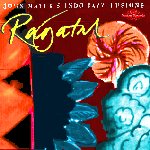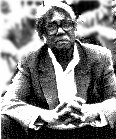[indo-jazz fusions] - [recordings] - [biography] - [reviews]
'Ragatal' & 'Indo-Jazz Fusions 1&2'
John Eyles: Avant magazine Issue 10 (winter 1999)
 About thirty years separate the recording dates of these two releases.
The 'Indo-Jazz Fusions' (combined here on one CD) were first released in
1967 and 1968. After Joe Harriott died in 1973, John Mayer did not want to
carry on with the band. Following a short-lived version with Steve
Williamson earlier in the decade, Mayer formed the new Indo-jazz Fusions in
1995. 'Ragatal', their second release, was recorded in October 1997.
Listening to these two CD's back-to-back sheds light on the changes of the
past thirty year. Indian music was fashionable in the late 60's, thanks to
the likes of George Harrison and Donovan, and their patronage of Ravi
Shankar. However, cross fertilisation between different traditions was
rare. Despite jazz musicians like Yusef Lateef and Coltrane displaying
Eastern influences, 'World Music' was many years away. In that climate,
'Indo-Jazz Fusions' was a bold, innovative and influential record. Despite
the title, this never sounds like fusion of raga and jazz. Passages of jazz
alternate with raga. There is little here that has ambiguous origins. The
more rigid discipline of the raga is dominant rhythmically and texturally,
with the jazz players making compromises to fit in. Those looking for a
source of Joe Harriott's legendary status will not find it here (try 'Free
Form' instead). Nonetheless, this is fascinating music that stands up well
to repeated listening.
About thirty years separate the recording dates of these two releases.
The 'Indo-Jazz Fusions' (combined here on one CD) were first released in
1967 and 1968. After Joe Harriott died in 1973, John Mayer did not want to
carry on with the band. Following a short-lived version with Steve
Williamson earlier in the decade, Mayer formed the new Indo-jazz Fusions in
1995. 'Ragatal', their second release, was recorded in October 1997.
Listening to these two CD's back-to-back sheds light on the changes of the
past thirty year. Indian music was fashionable in the late 60's, thanks to
the likes of George Harrison and Donovan, and their patronage of Ravi
Shankar. However, cross fertilisation between different traditions was
rare. Despite jazz musicians like Yusef Lateef and Coltrane displaying
Eastern influences, 'World Music' was many years away. In that climate,
'Indo-Jazz Fusions' was a bold, innovative and influential record. Despite
the title, this never sounds like fusion of raga and jazz. Passages of jazz
alternate with raga. There is little here that has ambiguous origins. The
more rigid discipline of the raga is dominant rhythmically and texturally,
with the jazz players making compromises to fit in. Those looking for a
source of Joe Harriott's legendary status will not find it here (try 'Free
Form' instead). Nonetheless, this is fascinating music that stands up well
to repeated listening.
Jumping ahead thirty years, to current incarnations of the group, we find a very different story. Music is now global; cross-fertilisation between different traditions (deliberate or otherwise) is the norm. Significantly, the group is no longer called 'a double quintet' (i.e one jazz, one Indian), it is an integrated ensemble; the Indian and jazz elements are now more fully and successfully blended than in the Harriott group. There are other elements of World Music too; 'Miyan ki Malhar' has distinctly South African rhythms.
Despite the inclusion of instrumentation associated with jazz (sax, trumpet, double bass) the music is almost all scored, even the solos, John Mayer does not believe in too much improvisation - after all, he is Professor of Composition and Composer in Residence at Birmingham Conservatoire!
However, some solos do sound very spontaineous and in the jazz tradition. Anna Brooks tenor solo in 'Partita' would not be out of place on a Stan Getz record. Even though there is genuine fusion in this music, to my ears the dominant sound is still that of India. Maybe Indian ears would say the jazz influence dominates. Anyway, Duke Ellington said, 'There are two types of music - good and bad.' This is good.
Pulse Tower Records magazine. U S A (April 1999)
Ragatal - Indo-Jazz Fusions
NIMBUS NI 55569
During the 1960's, British Indian-jazz fusion was spearheaded by an ensemble called Indo-Jazz Fusions (released on Atlantic in the U.S. and now reissued by Polygram / Redial in the U.K.) in much the way that Don Ellis and the Hindustani Jazz Sextet wrote the book stateside. The Jamiacan jazz saxophonist Joe Harriott and the keyboardist and Calcutta-born violinist John Mayer fronted them. Ragatal is the 1998 Mayer-led incarnation of the ensemble (Harriott died in 1973 and Shake Keane, the band's trumpeter, in 1997). It spills over with ideas, excellently realized by a 10-piece ensemble. Two pieces, "Partita" and "Multani" (recorded on the 1967 album), are reprised. The new blood captures an Indian flow of ideas, melodic and metrical (the raga and taal of the title), in a far more accomplished fashion than their earlier namestake which, to generalize, swung more (as in practiced less). The joy at having Mayer back and, with his son Jonathan on sitar, is immeasurable.
Jonathan Webster: Classic CD magazine (December 1998)
Indian-jazz fusion bands are not exactly falling out of the trees, so it's heartening to know this sorry gap in the recorded repertoire is about to be filled. Indo-Jazz Fusions is the ensemble directed by John Mayer who is currently professor of composition and Composer-in-Residence at Birmingham Conservatoire.
 Mayer has campaigned all his life against what he calls "musical apartheid", and as the name suggests what John aims for and gets is a seamless fusion between the Indian and jazz traditions. With the exception of his tabla player, Haqinder Matharu, all the other musicians on Ragatal are white but seem to have an uncannily inherent understanding of both traditions.
Mayer has campaigned all his life against what he calls "musical apartheid", and as the name suggests what John aims for and gets is a seamless fusion between the Indian and jazz traditions. With the exception of his tabla player, Haqinder Matharu, all the other musicians on Ragatal are white but seem to have an uncannily inherent understanding of both traditions.
Although the music swings and sounds free-wheeling it is actually pretty tightly structured. It is all scored, and improvisation happens in such a way that the player is reminded of the notes of the raga which holds each piece together. Some of the music actually uses the notes of a raga, and some adopts ideas from one. No.5 (Miyan ki Mathar) written by Indo-Jazz's keyboardist Steve Tromans, manages to go one step better and sound western, Indian and Latin all at the same time.
The players are astonishingly virtuosic from Mayer's son, Jonathan, on the sitar to Anna Brooks playing a sexy saxophone. An intoxicating mix ...(****)